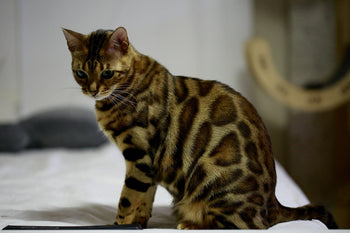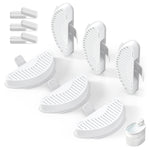Many people have grown up with the idea that cats love milk. From cartoons to children's books, cats and milk seem to go hand in hand. However, the question remains: do cats drink milk? The answer may surprise you.
While cats may love the taste of milk, it is not a necessary part of their diet. In fact, many cats are lactose intolerant, meaning that their bodies cannot properly digest the lactose found in milk. This can lead to digestive issues such as diarrhea and vomiting. Additionally, milk is not a complete source of nutrition for cats and should not be used as a replacement for their regular food.
So, if cats shouldn't drink milk, what should they drink? Water is the most important drink for cats. It helps keep them hydrated and aids in digestion. Some cats may prefer running water, so a fountain may be a good investment. Wet food can also help contribute to a cat's water intake. Overall, it's important to make sure your cat always has access to clean, fresh water.
Do Cats Drink Milk? The Truth About Cats and Dairy Consumption
Key Takeaways
Cats do not need to drink milk and may actually be lactose intolerant.
Water is the most important drink for cats and aids in hydration and digestion.
Wet food can also contribute to a cat's water intake.
What Do Cats Drink?
Cats, like all living creatures, need to drink water to survive. Water is essential for maintaining bodily functions, regulating body temperature, and removing waste products. However, many cat owners wonder if cats can drink milk instead of water.
Importance of Water

Water is the most critical nutrient for cats. It makes up about 60% of their body weight and is necessary for proper digestion, circulation, and overall health. Without enough water, cats can become dehydrated, which can lead to serious health problems.
Water as the Best Drink
While cats can drink milk, it should not be their primary source of hydration. Milk is high in fat and lactose, which can cause digestive issues in cats, especially those who are lactose intolerant. Water is the best drink for cats, and they should have access to fresh, clean water at all times.
Milk and Digestive Issues
While some cats can tolerate milk, many cannot. Consuming milk can cause diarrhea, vomiting, and other digestive problems. If your cat has already consumed milk and is experiencing digestive issues, it is best to consult with a veterinarian.
Related Posts:
Do Cats Drink Milk?
Milk Drinking Myth
Many people believe that cats love to drink milk, as they have seen it in movies and cartoons. However, the truth is that not all cats can tolerate milk. In fact, most adult cats are lactose intolerant, which means they cannot digest lactose, the sugar found in milk. Feeding cats milk can cause digestive problems such as diarrhea, vomiting, and upset stomach.
Lactose Intolerance in Cats
Lactose intolerance is a common condition in cats, and it is more prevalent in some breeds than others. Kittens can digest lactose, but as they grow older, their bodies produce less lactase, the enzyme that breaks down lactose. As a result, adult cats cannot digest lactose properly, and feeding them milk can lead to digestive issues.
Safe Drink Alternatives
While cats cannot drink regular cow's milk, there are other safe alternatives that they can enjoy. For example, lactose-free milk, such as goat's milk or specially formulated cat milk, can be given to cats in moderation. Additionally, cats should always have access to fresh, clean water, which is essential for their health and well-being.
In conclusion, while cats may enjoy the taste of milk, it is not a necessary or healthy part of their diet. Most adult cats are lactose intolerant, and feeding them milk can cause digestive problems. Instead, cat owners should provide their pets with safe drink alternatives and plenty of fresh water to keep them healthy and happy.
Tips for Keeping Your Cat Hydrated
Encouraging Water Consumption
Cats are notorious for being finicky about their water sources, which is why it's important to encourage them to drink water regularly. One way to do this is by providing them with fresh, clean water at all times. Consider investing in a cat water fountain, which can provide a constant flow of fresh water that is more appealing to cats than stagnant water in a bowl.
Another way to encourage water consumption is by adding wet food to their diet. Wet food contains more moisture than dry food, which can help keep your cat hydrated. Additionally, consider adding water to your cat's food to increase their water intake.

Monitoring Water Intake
It's important to monitor your cat's water intake to ensure they are staying hydrated. Keep track of how much water they drink each day, and make note of any changes in their behavior or health that may indicate dehydration.
If you notice that your cat is not drinking enough water, try changing the location of their water bowl or adding more water sources throughout your home. You can also try adding flavor to their water, such as a small amount of tuna juice, to make it more appealing.
By taking steps to encourage water consumption and monitoring your cat's water intake, you can help ensure that they stay hydrated and healthy.
Related Posts:
Conclusion
In conclusion, while cats have a reputation for loving milk, it is not a necessary part of their diet. In fact, many cats are lactose intolerant and can experience digestive issues if they consume too much milk.
It is important for cat owners to provide their pets with a balanced and nutritionally complete diet that meets their specific needs. This can include commercial cat food, as well as occasional treats such as small amounts of plain, unsweetened yogurt or cheese.
Overall, while cats may enjoy the taste of milk, it is not a necessary or recommended part of their diet. By providing them with a balanced and appropriate diet, cat owners can help their pets live healthy and happy lives.
Why Choose Uahpet?
For cat owners who want to provide their feline companions with fresh, clean water, the Uahpet cat water fountain is an excellent choice. This innovative fountain offers a range of features that make it stand out from other options on the market.
One of the key benefits of the Uahpet cat water fountain is its ease of cleaning. The fountain's unique design includes a separate water pump, which simplifies the cleaning process and minimizes bacterial buildup. This helps to ensure a healthier drinking environment for your cat.
Another major advantage of the Uahpet cat water fountain is its advanced 6-level filtration system. This multi-stage system is designed to provide the cleanest water possible for your pet. It includes an eco-friendly filter case that keeps the system sustainable and prevents food particles from contaminating the water. The system also includes KDF media, which removes heavy metals to protect your pet's organs, and ion exchange resin, which softens the water and reduces the risk of kidney stones. Quartz sand is used to prevent abdominal discomfort, while coconut activated charcoal safeguards your pet's sensory organs. Finally, PP woven folding cotton acts as a barrier against parasites and filters out pet hair.
In addition to its cleaning and filtration features, the Uahpet cat water fountain is also designed for user-friendly maintenance. Its wider structure and fewer parts make cleaning and reassembly a breeze. The fountain is also cordless, which means you can place it anywhere without worrying about power outlets or unsightly cords. And with a noise level of only 30 dB, the fountain operates silently, making it ideal for households with light sleepers.
Finally, the Uahpet cat water fountain is equipped with a long-lasting battery that provides up to 120 days of standby time. This reduces the need for frequent recharging and ensures that your cat always has access to fresh water.
Overall, the Uahpet cat water fountain offers a range of features that make it an excellent choice for cat owners who want to provide their pets with fresh, clean water. Its innovative design, advanced filtration system, and user-friendly features make it a top choice for pet owners everywhere.
Frequently Asked Questions
What should I do if my cat has ingested milk?
If your cat has ingested milk and is not showing any signs of discomfort or digestive issues, there is no need to worry. However, if your cat is lactose intolerant, it may experience diarrhea or vomiting. In such cases, it is advisable to contact a veterinarian.
Is the belief that cats need milk a myth or a fact?
The belief that cats need milk is a myth. While kittens require milk for their initial growth and development, adult cats do not need milk as a part of their regular diet. In fact, many adult cats are lactose intolerant, which means that they may experience digestive issues if they consume milk.
Should cats be given water instead of milk?
Yes, cats should be given water instead of milk. Water is essential for cats to maintain proper hydration, and it helps in the proper functioning of their organs.
What types of milk are safe for cats to consume?
Cats can consume milk that is specifically formulated for them, such as lactose-free milk or milk replacers. However, it is important to note that milk should not be a regular part of a cat's diet, and it should only be given in moderation.
What are the potential risks of giving milk to cats?
The potential risks of giving milk to cats include digestive issues, such as diarrhea and vomiting. Additionally, some cats may be allergic to milk, which can lead to more severe reactions.
How do portrayals of cats drinking milk in media differ from reality?
Portrayals of cats drinking milk in media are often inaccurate. While it may be cute to see a cat lapping up a bowl of milk in a cartoon or movie, the reality is that many cats are lactose intolerant and cannot digest milk properly. It is important to remember that cats should not be given milk as a regular part of their diet and that water is the best option for their hydration needs.














